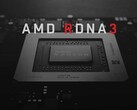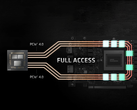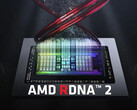In an interview with online publication The Street, AMD’s Executive Vice President Rick Bergman provided some interesting facts about the upcoming RDNA 3 GPU architecture and the Zen 4 CPU architecture. It is interesting to see AMD already planning ahead for the next iterations when we have barely seen what the new Zen 3 CPUS and RDNA 2 GPUs are capable of. This could further prove that AMD is looking to commit to releasing substantially improved versions on a yearly basis.
When asked about the benefits of the RDNA 3 architecture over the RDNA 2 one currently powering the new Radeon RX 6800 / XT and RX 6900 XT GPUs, Bergman quickly pointed out that the performance-per-watt gains should be similar to the improvements achieved with the leap from RDNA 1 to RDNA 2. “... We have the same commitment on RDNA 3… We focused on that on RDNA 2. It's a big focus on RDNA 3 as well.” Bergman notes that the key here is to maintain a similar TGP while delivering 50% more performance so potential users are not forced to buy bigger power supplies and replace the cooling solutions like with Nvidia's RTX 3000 cards. We are still not sure if this will be facilitated through the use of the advanced TSMC 5 nm nodes. From what we heard in previous rumors, it looks like both RDNA 3 and Zen 4 should use the 5 nm nodes, and Bergman seems to indirectly confirm this as he is corroborating the RDNA 3 performance gains with the expected Zen 4 gains. We are also hearing that the RDNA 3 GPUs will adopt a multi-chip module (MCM) approach.
Bergman also explained that the top-of-the-line RDNA 2 GPUs are designed to provide a smooth ray traced experience at 1440p resolutions. Additionally, AMD’s answer to Nvidia’s DLSS will come in the form of FSR (FidelityFX Super Resolution) but there is no exact time frame for its arrival. In this respect, Bergman stated that AMD is “committed to getting that feature implemented, and we're working with ISVs (independent software vendors) at this point. I’ll just say AMD’s approach on these types of technologies is to make sure we have broad platform support, and not require proprietary solutions from the ISVs. And that's the approach that we're taking. So as we go through next year, you'll get a lot more details on it.”


 Deutsch
Deutsch English
English Español
Español Français
Français Italiano
Italiano Nederlands
Nederlands Polski
Polski Português
Português Русский
Русский Türkçe
Türkçe Svenska
Svenska Chinese
Chinese Magyar
Magyar










